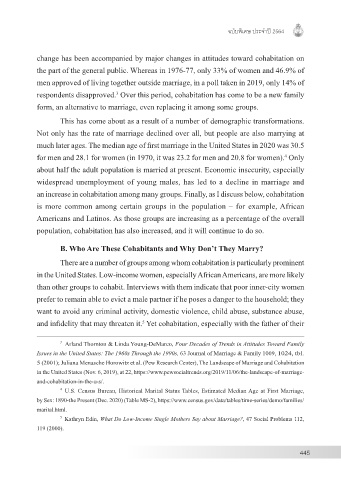Page 447 - วารสารกฎหมาย ศาลอุทธรณ์คดีชํานัญพิเศษ
P. 447
ฉบับพิเศษ ประจำ�ปี 2564
change has been accompanied by major changes in attitudes toward cohabitation on
the part of the general public. Whereas in 1976-77, only 33% of women and 46.9% of
men approved of living together outside marriage, in a poll taken in 2019, only 14% of
respondents disapproved. Over this period, cohabitation has come to be a new family
3
form, an alternative to marriage, even replacing it among some groups.
This has come about as a result of a number of demographic transformations.
Not only has the rate of marriage declined over all, but people are also marrying at
much later ages. The median age of first marriage in the United States in 2020 was 30.5
for men and 28.1 for women (in 1970, it was 23.2 for men and 20.8 for women). Only
4
about half the adult population is married at present. Economic insecurity, especially
widespread unemployment of young males, has led to a decline in marriage and
an increase in cohabitation among many groups. Finally, as I discuss below, cohabitation
is more common among certain groups in the population – for example, African
Americans and Latinos. As those groups are increasing as a percentage of the overall
population, cohabitation has also increased, and it will continue to do so.
B. Who Are These Cohabitants and Why Don’t They Marry?
There are a number of groups among whom cohabitation is particularly prominent
in the United States. Low-income women, especially African Americans, are more likely
than other groups to cohabit. Interviews with them indicate that poor inner-city women
prefer to remain able to evict a male partner if he poses a danger to the household; they
want to avoid any criminal activity, domestic violence, child abuse, substance abuse,
and infidelity that may threaten it. Yet cohabitation, especially with the father of their
5
3 Arland Thornton & Linda Young-DeMarco, Four Decades of Trends in Attitudes Toward Family
Issues in the United States: The 1960s Through the 1990s, 63 Journal of Marriage & Family 1009, 1024, tbl.
5 (2001); Juliana Menasche Horowitz et al. (Pew Research Center), The Landscape of Marriage and Cohabitation
in the United States (Nov. 6, 2019), at 22, https://www.pewsocialtrends.org/2019/11/06/the-landscape-of-marriage-
and-cohabitation-in-the-u-s/.
4 U.S. Census Bureau, Historical Marital Status Tables, Estimated Median Age at First Marriage,
by Sex: 1890-the Present (Dec. 2020) (Table MS-2), https://www.census.gov/data/tables/time-series/demo/families/
marital.html.
5 Kathryn Edin, What Do Low-Income Single Mothers Say about Marriage?, 47 Social Problems 112,
119 (2000).
445

